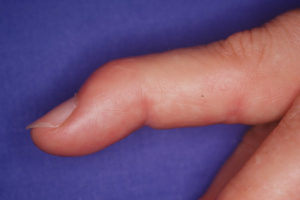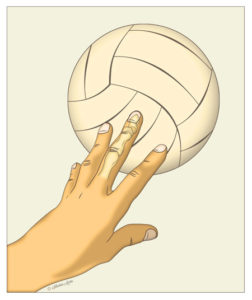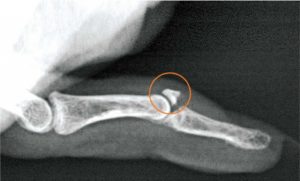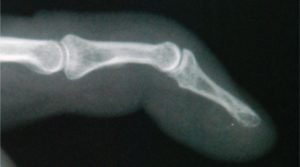A mallet finger is a deformity of the finger caused when the tendon that straightens your finger (extensor tendon) is damaged.

When a ball or other object strikes the tip of the finger or thumb and forcibly bends it, the force tears the tendon that straightens the finger. The force of the blow may even pull away a piece of bone along with the tendon. The finger or thumb is not able to straighten.
This condition is also sometimes referred to as baseball finger.
Symptoms
The key finding with a mallet finger is that the fingertip droops; that is, it cannot straighten on its own power. The finger may be painful, swollen and bruised, especially if there is an associated fracture, but often the only finding is the inability to straighten the tip. Occasionally, blood collects beneath the nail. The nail can even become detached from beneath the skin fold at the base of the nail.

Diagnosis

The diagnosis is evident by the appearance of the finger. X-rays are often ordered to see if you have pulled off a piece of bone and to make sure the joint is aligned.

Non surgical treatment
The majority of mallet finger injuries can be treated without surgery. Ice should be applied immediately, and the hand should be elevated (fingers toward the ceiling.) Medical attention should be sought within a week after injury. It is especially important to seek immediate attention if there is blood beneaththe nail or if the nail is detached. This may be a sign of a nail bed laceration or an open (compound) fracture.

There are many different types of splints/casts for mallet fingers. The goal is to keep the fingertip straight until the tendon heals. Most of the time, a splint will be worn full time for eight weeks. Over the next three to four weeks, most patients gradually begin to wear the splint less frequently. The finger usually regains acceptable function and appearance with this treatment. Nevertheless, it is not unusual to lack some extension at the conclusion of treatment. Your surgeon will instruct you about how to wear the splint and will also show you exercises to maintain motion in the middle joint (proximal interphalangeal joint) so your finger does not become stiff. Once your surgeon feels your mallet finger has healed, he/she will show you exercises to regain motion in the fingertip itself.
In children, mallet finger injuries may involve the cartilage that controls bone growth. The doctor must carefully evaluate and treat this injury in children, so that the finger does not become stunted or deformed.
Surgical treatment
Surgical repair may be considered when mallet finger injuries have large bone fragments or joint mal-alignment. In these cases, pins, wires or even small screws are used to secure the bone fragment and realign the joint. Surgery may also be considered if non-surgical treatment is not successful in restoring adequate finger extension. Surgical treatment of the damaged tendon can include tightening the stretched tendon tissue, using tendon grafts or even fusing the joint straight. Your surgeon will advise you on the best technique for your situation.
© 2011 American Society for Surgery of the Hand
Complications
No surgical intervention guarantees that there will not be secondary complications. Every decision which involves intervention should be aware of the risks that the surgeon has to inform you about.
Common complications related to hand surgery
- Nosocomial infections: they are rare and easily controlled with early diagnosis. Antibiotics and a new intervention may be necessary.
- Hematoma: the diagnosis must be early and surgical revision may also be necessary
- Sudeck syndrome (algodystrophy): this is a “disruptive” pain when there is no underlying problem. Its manifestation is independent of the type of surgery and can occur even after a simple immobilization. The hand becomes swollen, painful, and gradually stiffens. The evolution can be very long. Sequelae are possible (residual pain, the stiffness of the fingers and/or wrist, sometimes of the shoulder). Treatment is difficult and uses specific rehabilitation techniques
- Anaesthesia accident: the easiest but the most serious, including death (1 death per 100,000 to 150,000 anaesthesia).
Common complications related to the mallet finger:
- Persistence or recurrence of a deformity. The deformity persists despite treatment. This situation occurs in a non-exceptional way (15% of cases). Prolonging conservative treatment or surgical treatment may be justified in the event of poor tolerance (tenodermodesis).
- Partial loss of mobility. Inevitable (a few degrees).
- Prolonged pain. There is very often a particular sensitivity on the back of the finger, a burning sensation, particularly on the middle phalanx, for six months or even a year.
- Pinout complications: Infection.
- Nail deformity: Unpredictable and delayed onset, it is due to the impact of the rupture of the tendon on the very close matrix.

 Français
Français English
English